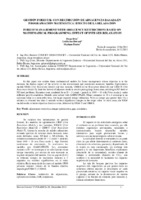Gestión forestal con restricción de adyacencia basada en programación matemática : efecto de la relajación
Forest management with adjacency restrictions based on mathematical programming : effect of integer relaxation
Date
2013-12-01Author
Broz, Diego Ricardo
Durand, Guillermo Andrés
Frutos, Mariano
Metadata
Show full item recordAbstract
Se estudian tres herramientas de gestión forestal, los modelos de optimización URM (Unit Restriction Model) y dos variantes, URM-E (Unit Restriction Model-E) y URM-T (Unit Restriction Model-T), limitan la cosecha de rodales adyacentes evitando apertura de extensas áreas boscosas, estos están definidos como NP-hard o NP-difíciles. Se simularon escenarios desde 30 × 3 (rodal × período) hasta 1000 × 10 con Pinus taeda L. bajo distintas condiciones de crecimiento. Se resolvieron los modelos con GAMS/CPLEX. Los escenarios menores a 50 × 6 convergen a un valor óptimo en un tiempo razonable, por encima de este escenario se requiere relajación del modelo. Con un gap de [0,01] se obtienen tiempos de resolución menores a 3 segundos sin cambios significativos en el valor objetivo. En la mayoría de los casos el modelo URM presenta mejores valores de la función objetivo seguido por URM-T y URM-E. In this paper was studies three mathematical models for forest management whose objective is to the decrease the human impact of the activity on the environment and maximizes economic benefits. Optimization models URM (Unit Restriction Model) and two variants, URM-E (Unit Restriction Model-E) and URM-T (Unit Restriction Model-T), limit the harvest of adjacent stands to avoid opening large forest areas, resulting in NP-hard or NP-hard problems. Scenarios were simulated from 30 × 3 (stand × period) to 1000 × 10 with Pinus taeda L. under different growth conditions. Models were solved with GAMS/CPLEX. Minor scenarios to 50 x 6 converge to an optimum value in a reasonable time, but larger required integer relaxation. With an integer gap greater than 1% a solution is obtained less than 3 seconds without significant changes in the target value. In most cases, the URM model results in better objective function value, followed by URM-T and URM-E.
URI
https://hdl.handle.net/20.500.12219/2702http://www.yvyrareta.com.ar/index.php/component/k2/item/77-gest-forest-rest
Collections
- Revista Yvyraretá [360]
The following license files are associated with this item:




